Multi-Drug Resistant Bacteria: Diagnostic Methods Comparison
VerifiedAdded on 2023/06/03
|10
|2418
|90
Report
AI Summary
This report provides a comprehensive overview of diagnostic methods used to identify and combat multi-drug resistant bacteria. It begins with an abstract highlighting the growing threat of antibiotic resistance and the mechanisms behind it. The introduction emphasizes the increasing health risk posed by drug-resistant bacterial infections and the efforts of researchers to understand and address this issue. The core of the report compares and contrasts various diagnostic techniques, including culture-based testing, which has historically been used, and molecular-based testing, such as PCR and FISH. The report details the advantages and limitations of each method, discussing their accuracy, speed, cost-effectiveness, and applicability. The report also highlights the importance of molecular techniques in providing timely and accurate results, enabling healthcare professionals to make informed decisions and administer effective antibiotic treatments. The conclusion underscores the significance of investing in advanced technology to address the prevalence of multi-drug resistant bacteria and save lives.

Student name
Student No.
Unit
Title: Multi-Drug Resistance Bacteria Diagnostic Methods
Student No.
Unit
Title: Multi-Drug Resistance Bacteria Diagnostic Methods
Paraphrase This Document
Need a fresh take? Get an instant paraphrase of this document with our AI Paraphraser
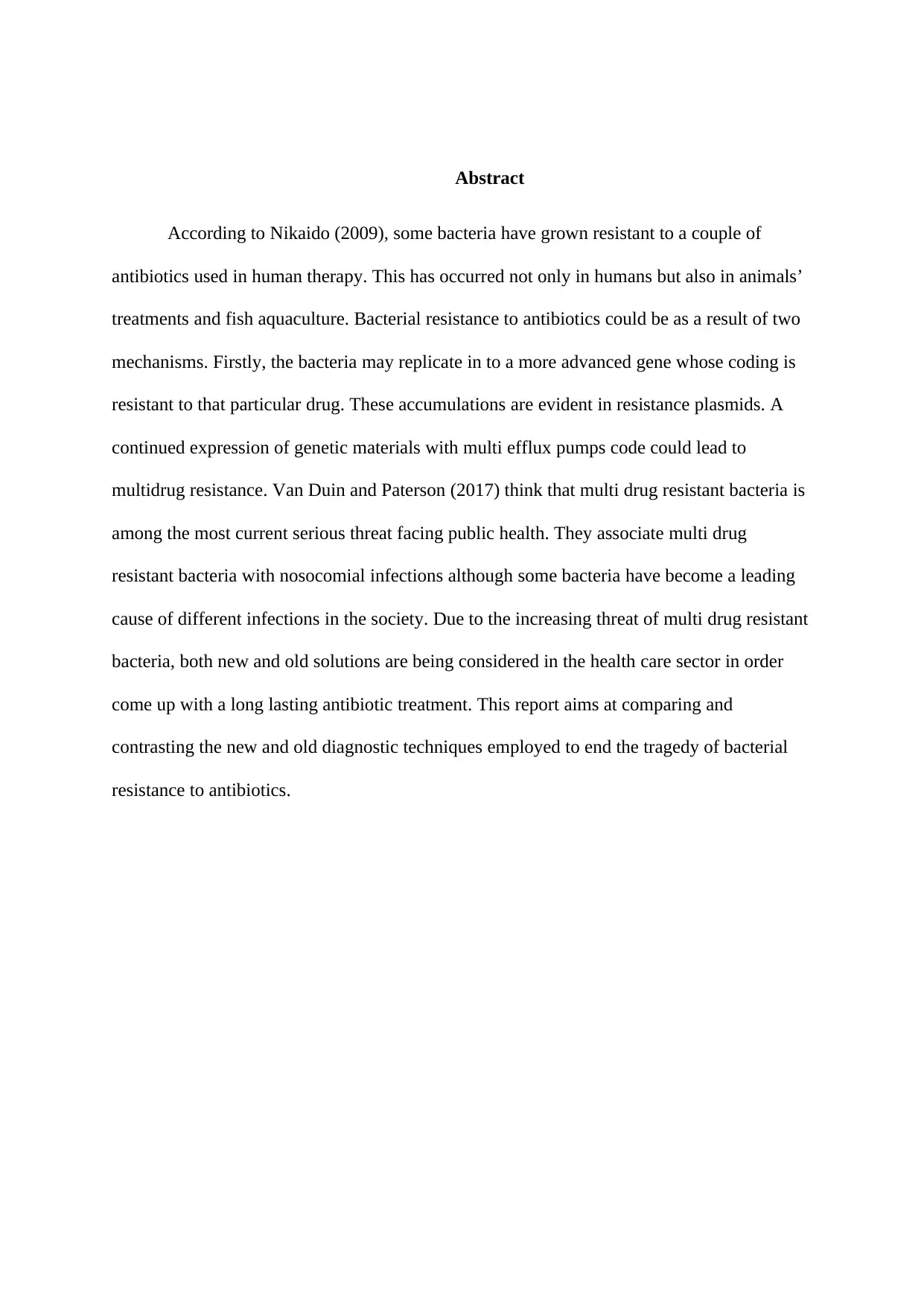
Abstract
According to Nikaido (2009), some bacteria have grown resistant to a couple of
antibiotics used in human therapy. This has occurred not only in humans but also in animals’
treatments and fish aquaculture. Bacterial resistance to antibiotics could be as a result of two
mechanisms. Firstly, the bacteria may replicate in to a more advanced gene whose coding is
resistant to that particular drug. These accumulations are evident in resistance plasmids. A
continued expression of genetic materials with multi efflux pumps code could lead to
multidrug resistance. Van Duin and Paterson (2017) think that multi drug resistant bacteria is
among the most current serious threat facing public health. They associate multi drug
resistant bacteria with nosocomial infections although some bacteria have become a leading
cause of different infections in the society. Due to the increasing threat of multi drug resistant
bacteria, both new and old solutions are being considered in the health care sector in order
come up with a long lasting antibiotic treatment. This report aims at comparing and
contrasting the new and old diagnostic techniques employed to end the tragedy of bacterial
resistance to antibiotics.
According to Nikaido (2009), some bacteria have grown resistant to a couple of
antibiotics used in human therapy. This has occurred not only in humans but also in animals’
treatments and fish aquaculture. Bacterial resistance to antibiotics could be as a result of two
mechanisms. Firstly, the bacteria may replicate in to a more advanced gene whose coding is
resistant to that particular drug. These accumulations are evident in resistance plasmids. A
continued expression of genetic materials with multi efflux pumps code could lead to
multidrug resistance. Van Duin and Paterson (2017) think that multi drug resistant bacteria is
among the most current serious threat facing public health. They associate multi drug
resistant bacteria with nosocomial infections although some bacteria have become a leading
cause of different infections in the society. Due to the increasing threat of multi drug resistant
bacteria, both new and old solutions are being considered in the health care sector in order
come up with a long lasting antibiotic treatment. This report aims at comparing and
contrasting the new and old diagnostic techniques employed to end the tragedy of bacterial
resistance to antibiotics.
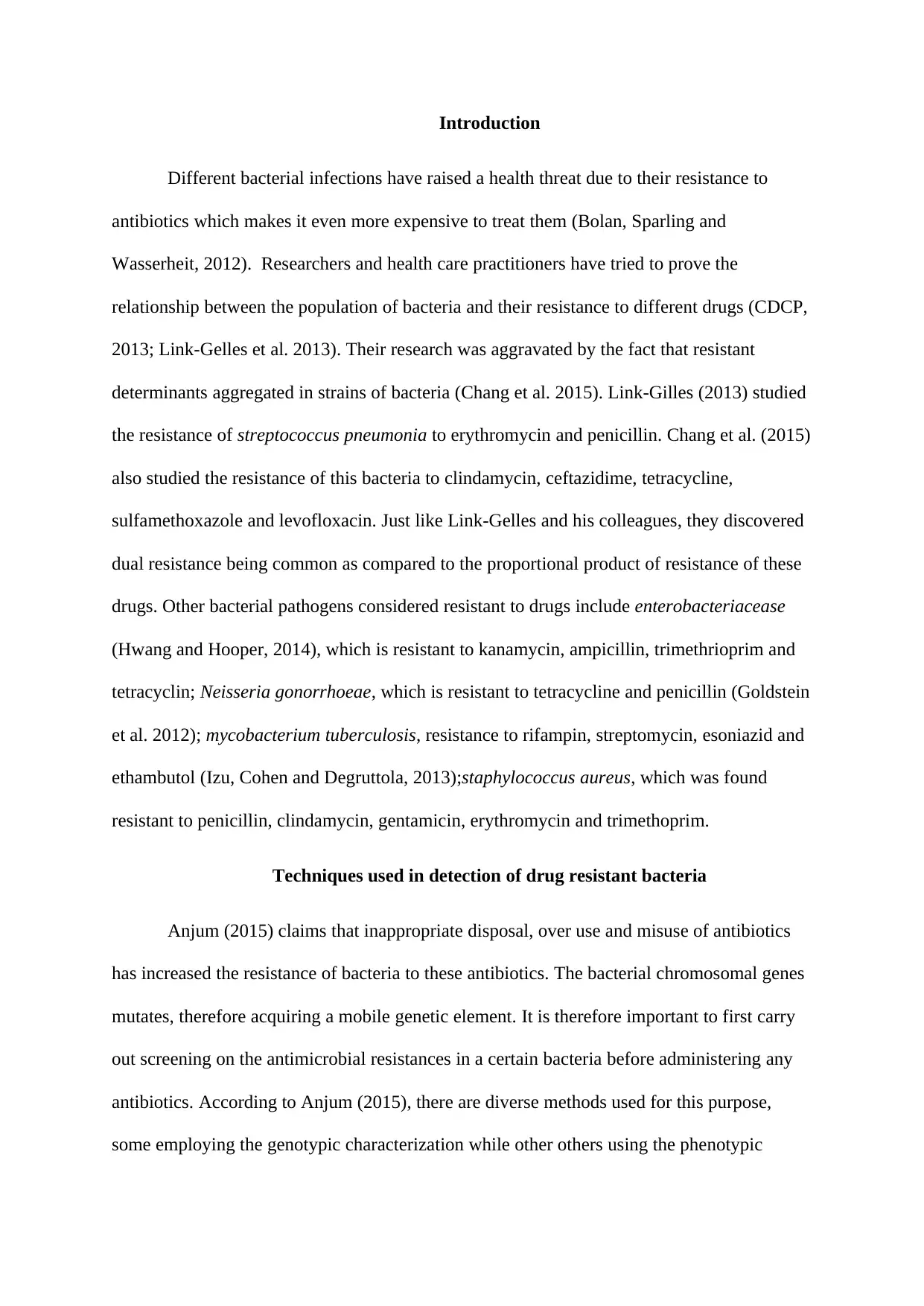
Introduction
Different bacterial infections have raised a health threat due to their resistance to
antibiotics which makes it even more expensive to treat them (Bolan, Sparling and
Wasserheit, 2012). Researchers and health care practitioners have tried to prove the
relationship between the population of bacteria and their resistance to different drugs (CDCP,
2013; Link-Gelles et al. 2013). Their research was aggravated by the fact that resistant
determinants aggregated in strains of bacteria (Chang et al. 2015). Link-Gilles (2013) studied
the resistance of streptococcus pneumonia to erythromycin and penicillin. Chang et al. (2015)
also studied the resistance of this bacteria to clindamycin, ceftazidime, tetracycline,
sulfamethoxazole and levofloxacin. Just like Link-Gelles and his colleagues, they discovered
dual resistance being common as compared to the proportional product of resistance of these
drugs. Other bacterial pathogens considered resistant to drugs include enterobacteriacease
(Hwang and Hooper, 2014), which is resistant to kanamycin, ampicillin, trimethrioprim and
tetracyclin; Neisseria gonorrhoeae, which is resistant to tetracycline and penicillin (Goldstein
et al. 2012); mycobacterium tuberculosis, resistance to rifampin, streptomycin, esoniazid and
ethambutol (Izu, Cohen and Degruttola, 2013);staphylococcus aureus, which was found
resistant to penicillin, clindamycin, gentamicin, erythromycin and trimethoprim.
Techniques used in detection of drug resistant bacteria
Anjum (2015) claims that inappropriate disposal, over use and misuse of antibiotics
has increased the resistance of bacteria to these antibiotics. The bacterial chromosomal genes
mutates, therefore acquiring a mobile genetic element. It is therefore important to first carry
out screening on the antimicrobial resistances in a certain bacteria before administering any
antibiotics. According to Anjum (2015), there are diverse methods used for this purpose,
some employing the genotypic characterization while other others using the phenotypic
Different bacterial infections have raised a health threat due to their resistance to
antibiotics which makes it even more expensive to treat them (Bolan, Sparling and
Wasserheit, 2012). Researchers and health care practitioners have tried to prove the
relationship between the population of bacteria and their resistance to different drugs (CDCP,
2013; Link-Gelles et al. 2013). Their research was aggravated by the fact that resistant
determinants aggregated in strains of bacteria (Chang et al. 2015). Link-Gilles (2013) studied
the resistance of streptococcus pneumonia to erythromycin and penicillin. Chang et al. (2015)
also studied the resistance of this bacteria to clindamycin, ceftazidime, tetracycline,
sulfamethoxazole and levofloxacin. Just like Link-Gelles and his colleagues, they discovered
dual resistance being common as compared to the proportional product of resistance of these
drugs. Other bacterial pathogens considered resistant to drugs include enterobacteriacease
(Hwang and Hooper, 2014), which is resistant to kanamycin, ampicillin, trimethrioprim and
tetracyclin; Neisseria gonorrhoeae, which is resistant to tetracycline and penicillin (Goldstein
et al. 2012); mycobacterium tuberculosis, resistance to rifampin, streptomycin, esoniazid and
ethambutol (Izu, Cohen and Degruttola, 2013);staphylococcus aureus, which was found
resistant to penicillin, clindamycin, gentamicin, erythromycin and trimethoprim.
Techniques used in detection of drug resistant bacteria
Anjum (2015) claims that inappropriate disposal, over use and misuse of antibiotics
has increased the resistance of bacteria to these antibiotics. The bacterial chromosomal genes
mutates, therefore acquiring a mobile genetic element. It is therefore important to first carry
out screening on the antimicrobial resistances in a certain bacteria before administering any
antibiotics. According to Anjum (2015), there are diverse methods used for this purpose,
some employing the genotypic characterization while other others using the phenotypic
⊘ This is a preview!⊘
Do you want full access?
Subscribe today to unlock all pages.

Trusted by 1+ million students worldwide
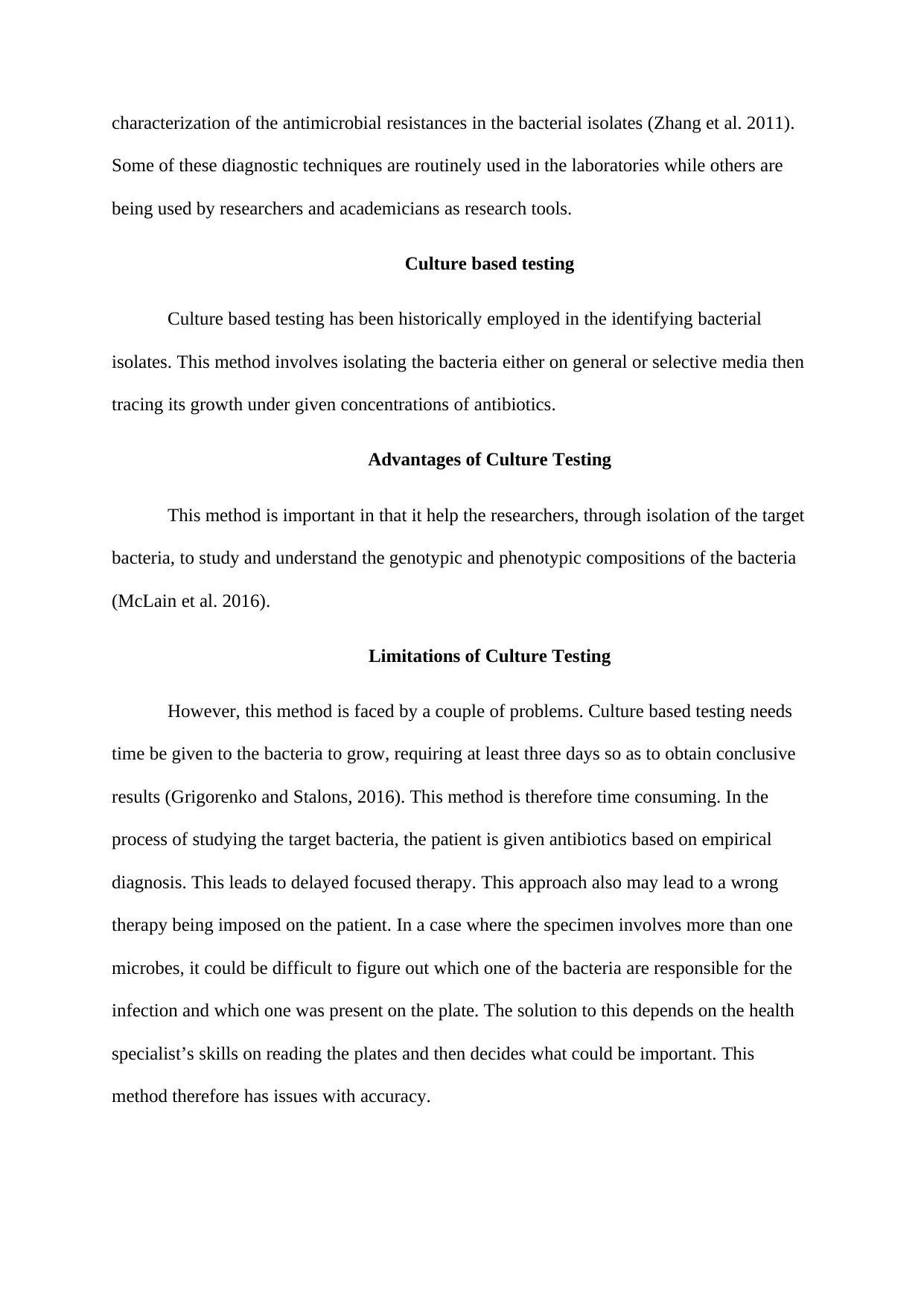
characterization of the antimicrobial resistances in the bacterial isolates (Zhang et al. 2011).
Some of these diagnostic techniques are routinely used in the laboratories while others are
being used by researchers and academicians as research tools.
Culture based testing
Culture based testing has been historically employed in the identifying bacterial
isolates. This method involves isolating the bacteria either on general or selective media then
tracing its growth under given concentrations of antibiotics.
Advantages of Culture Testing
This method is important in that it help the researchers, through isolation of the target
bacteria, to study and understand the genotypic and phenotypic compositions of the bacteria
(McLain et al. 2016).
Limitations of Culture Testing
However, this method is faced by a couple of problems. Culture based testing needs
time be given to the bacteria to grow, requiring at least three days so as to obtain conclusive
results (Grigorenko and Stalons, 2016). This method is therefore time consuming. In the
process of studying the target bacteria, the patient is given antibiotics based on empirical
diagnosis. This leads to delayed focused therapy. This approach also may lead to a wrong
therapy being imposed on the patient. In a case where the specimen involves more than one
microbes, it could be difficult to figure out which one of the bacteria are responsible for the
infection and which one was present on the plate. The solution to this depends on the health
specialist’s skills on reading the plates and then decides what could be important. This
method therefore has issues with accuracy.
Some of these diagnostic techniques are routinely used in the laboratories while others are
being used by researchers and academicians as research tools.
Culture based testing
Culture based testing has been historically employed in the identifying bacterial
isolates. This method involves isolating the bacteria either on general or selective media then
tracing its growth under given concentrations of antibiotics.
Advantages of Culture Testing
This method is important in that it help the researchers, through isolation of the target
bacteria, to study and understand the genotypic and phenotypic compositions of the bacteria
(McLain et al. 2016).
Limitations of Culture Testing
However, this method is faced by a couple of problems. Culture based testing needs
time be given to the bacteria to grow, requiring at least three days so as to obtain conclusive
results (Grigorenko and Stalons, 2016). This method is therefore time consuming. In the
process of studying the target bacteria, the patient is given antibiotics based on empirical
diagnosis. This leads to delayed focused therapy. This approach also may lead to a wrong
therapy being imposed on the patient. In a case where the specimen involves more than one
microbes, it could be difficult to figure out which one of the bacteria are responsible for the
infection and which one was present on the plate. The solution to this depends on the health
specialist’s skills on reading the plates and then decides what could be important. This
method therefore has issues with accuracy.
Paraphrase This Document
Need a fresh take? Get an instant paraphrase of this document with our AI Paraphraser
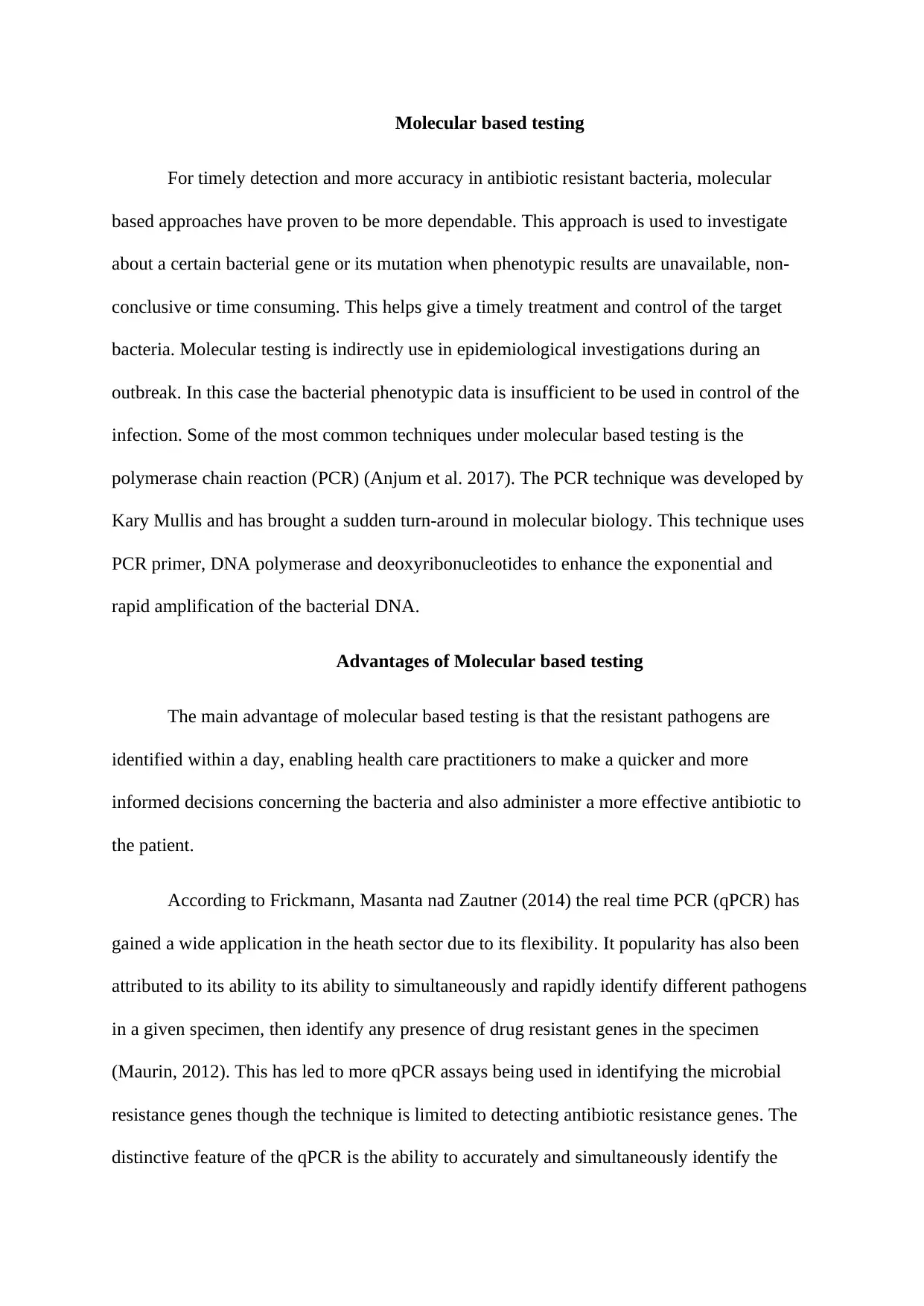
Molecular based testing
For timely detection and more accuracy in antibiotic resistant bacteria, molecular
based approaches have proven to be more dependable. This approach is used to investigate
about a certain bacterial gene or its mutation when phenotypic results are unavailable, non-
conclusive or time consuming. This helps give a timely treatment and control of the target
bacteria. Molecular testing is indirectly use in epidemiological investigations during an
outbreak. In this case the bacterial phenotypic data is insufficient to be used in control of the
infection. Some of the most common techniques under molecular based testing is the
polymerase chain reaction (PCR) (Anjum et al. 2017). The PCR technique was developed by
Kary Mullis and has brought a sudden turn-around in molecular biology. This technique uses
PCR primer, DNA polymerase and deoxyribonucleotides to enhance the exponential and
rapid amplification of the bacterial DNA.
Advantages of Molecular based testing
The main advantage of molecular based testing is that the resistant pathogens are
identified within a day, enabling health care practitioners to make a quicker and more
informed decisions concerning the bacteria and also administer a more effective antibiotic to
the patient.
According to Frickmann, Masanta nad Zautner (2014) the real time PCR (qPCR) has
gained a wide application in the heath sector due to its flexibility. It popularity has also been
attributed to its ability to its ability to simultaneously and rapidly identify different pathogens
in a given specimen, then identify any presence of drug resistant genes in the specimen
(Maurin, 2012). This has led to more qPCR assays being used in identifying the microbial
resistance genes though the technique is limited to detecting antibiotic resistance genes. The
distinctive feature of the qPCR is the ability to accurately and simultaneously identify the
For timely detection and more accuracy in antibiotic resistant bacteria, molecular
based approaches have proven to be more dependable. This approach is used to investigate
about a certain bacterial gene or its mutation when phenotypic results are unavailable, non-
conclusive or time consuming. This helps give a timely treatment and control of the target
bacteria. Molecular testing is indirectly use in epidemiological investigations during an
outbreak. In this case the bacterial phenotypic data is insufficient to be used in control of the
infection. Some of the most common techniques under molecular based testing is the
polymerase chain reaction (PCR) (Anjum et al. 2017). The PCR technique was developed by
Kary Mullis and has brought a sudden turn-around in molecular biology. This technique uses
PCR primer, DNA polymerase and deoxyribonucleotides to enhance the exponential and
rapid amplification of the bacterial DNA.
Advantages of Molecular based testing
The main advantage of molecular based testing is that the resistant pathogens are
identified within a day, enabling health care practitioners to make a quicker and more
informed decisions concerning the bacteria and also administer a more effective antibiotic to
the patient.
According to Frickmann, Masanta nad Zautner (2014) the real time PCR (qPCR) has
gained a wide application in the heath sector due to its flexibility. It popularity has also been
attributed to its ability to its ability to simultaneously and rapidly identify different pathogens
in a given specimen, then identify any presence of drug resistant genes in the specimen
(Maurin, 2012). This has led to more qPCR assays being used in identifying the microbial
resistance genes though the technique is limited to detecting antibiotic resistance genes. The
distinctive feature of the qPCR is the ability to accurately and simultaneously identify the
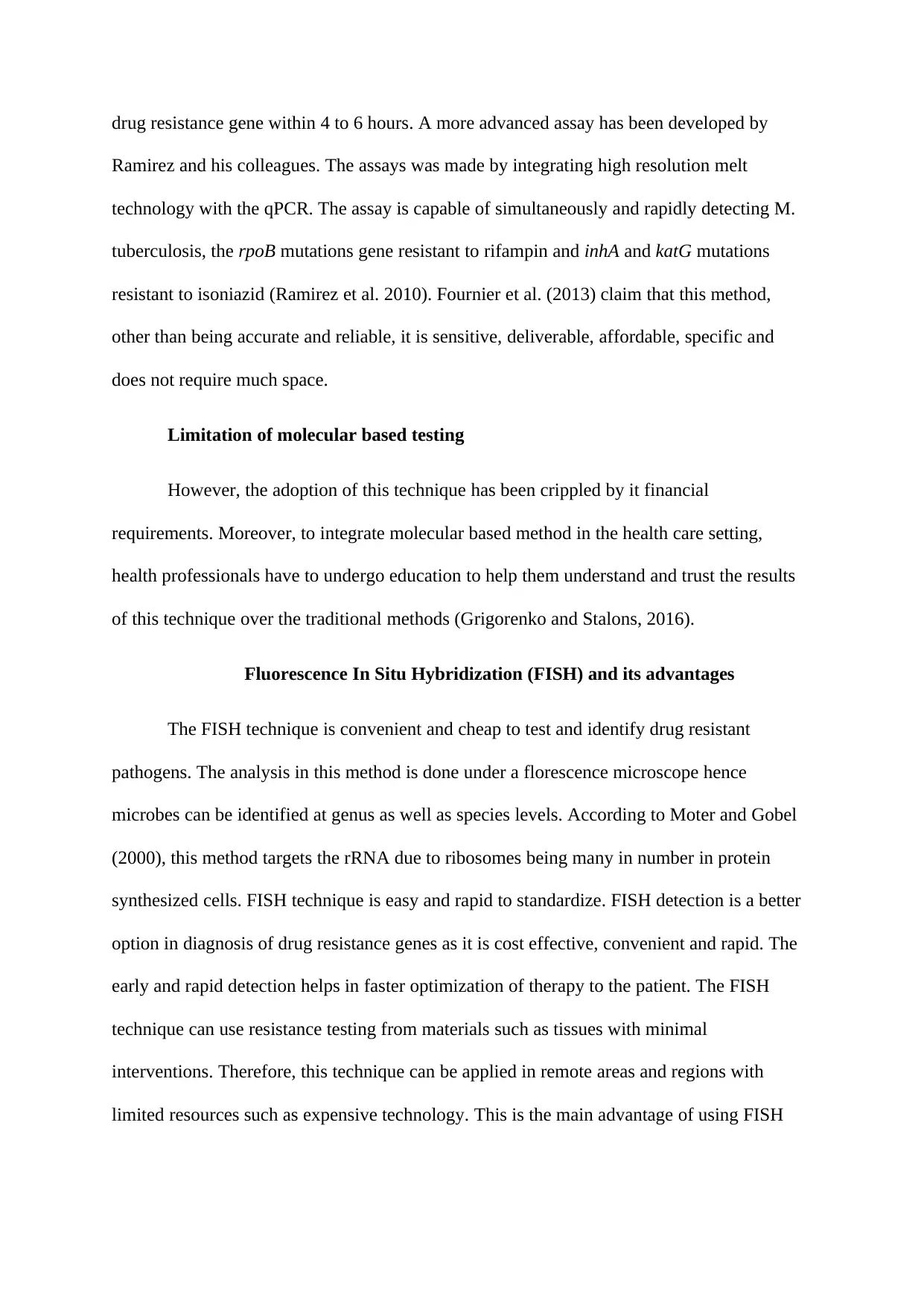
drug resistance gene within 4 to 6 hours. A more advanced assay has been developed by
Ramirez and his colleagues. The assays was made by integrating high resolution melt
technology with the qPCR. The assay is capable of simultaneously and rapidly detecting M.
tuberculosis, the rpoB mutations gene resistant to rifampin and inhA and katG mutations
resistant to isoniazid (Ramirez et al. 2010). Fournier et al. (2013) claim that this method,
other than being accurate and reliable, it is sensitive, deliverable, affordable, specific and
does not require much space.
Limitation of molecular based testing
However, the adoption of this technique has been crippled by it financial
requirements. Moreover, to integrate molecular based method in the health care setting,
health professionals have to undergo education to help them understand and trust the results
of this technique over the traditional methods (Grigorenko and Stalons, 2016).
Fluorescence In Situ Hybridization (FISH) and its advantages
The FISH technique is convenient and cheap to test and identify drug resistant
pathogens. The analysis in this method is done under a florescence microscope hence
microbes can be identified at genus as well as species levels. According to Moter and Gobel
(2000), this method targets the rRNA due to ribosomes being many in number in protein
synthesized cells. FISH technique is easy and rapid to standardize. FISH detection is a better
option in diagnosis of drug resistance genes as it is cost effective, convenient and rapid. The
early and rapid detection helps in faster optimization of therapy to the patient. The FISH
technique can use resistance testing from materials such as tissues with minimal
interventions. Therefore, this technique can be applied in remote areas and regions with
limited resources such as expensive technology. This is the main advantage of using FISH
Ramirez and his colleagues. The assays was made by integrating high resolution melt
technology with the qPCR. The assay is capable of simultaneously and rapidly detecting M.
tuberculosis, the rpoB mutations gene resistant to rifampin and inhA and katG mutations
resistant to isoniazid (Ramirez et al. 2010). Fournier et al. (2013) claim that this method,
other than being accurate and reliable, it is sensitive, deliverable, affordable, specific and
does not require much space.
Limitation of molecular based testing
However, the adoption of this technique has been crippled by it financial
requirements. Moreover, to integrate molecular based method in the health care setting,
health professionals have to undergo education to help them understand and trust the results
of this technique over the traditional methods (Grigorenko and Stalons, 2016).
Fluorescence In Situ Hybridization (FISH) and its advantages
The FISH technique is convenient and cheap to test and identify drug resistant
pathogens. The analysis in this method is done under a florescence microscope hence
microbes can be identified at genus as well as species levels. According to Moter and Gobel
(2000), this method targets the rRNA due to ribosomes being many in number in protein
synthesized cells. FISH technique is easy and rapid to standardize. FISH detection is a better
option in diagnosis of drug resistance genes as it is cost effective, convenient and rapid. The
early and rapid detection helps in faster optimization of therapy to the patient. The FISH
technique can use resistance testing from materials such as tissues with minimal
interventions. Therefore, this technique can be applied in remote areas and regions with
limited resources such as expensive technology. This is the main advantage of using FISH
⊘ This is a preview!⊘
Do you want full access?
Subscribe today to unlock all pages.

Trusted by 1+ million students worldwide
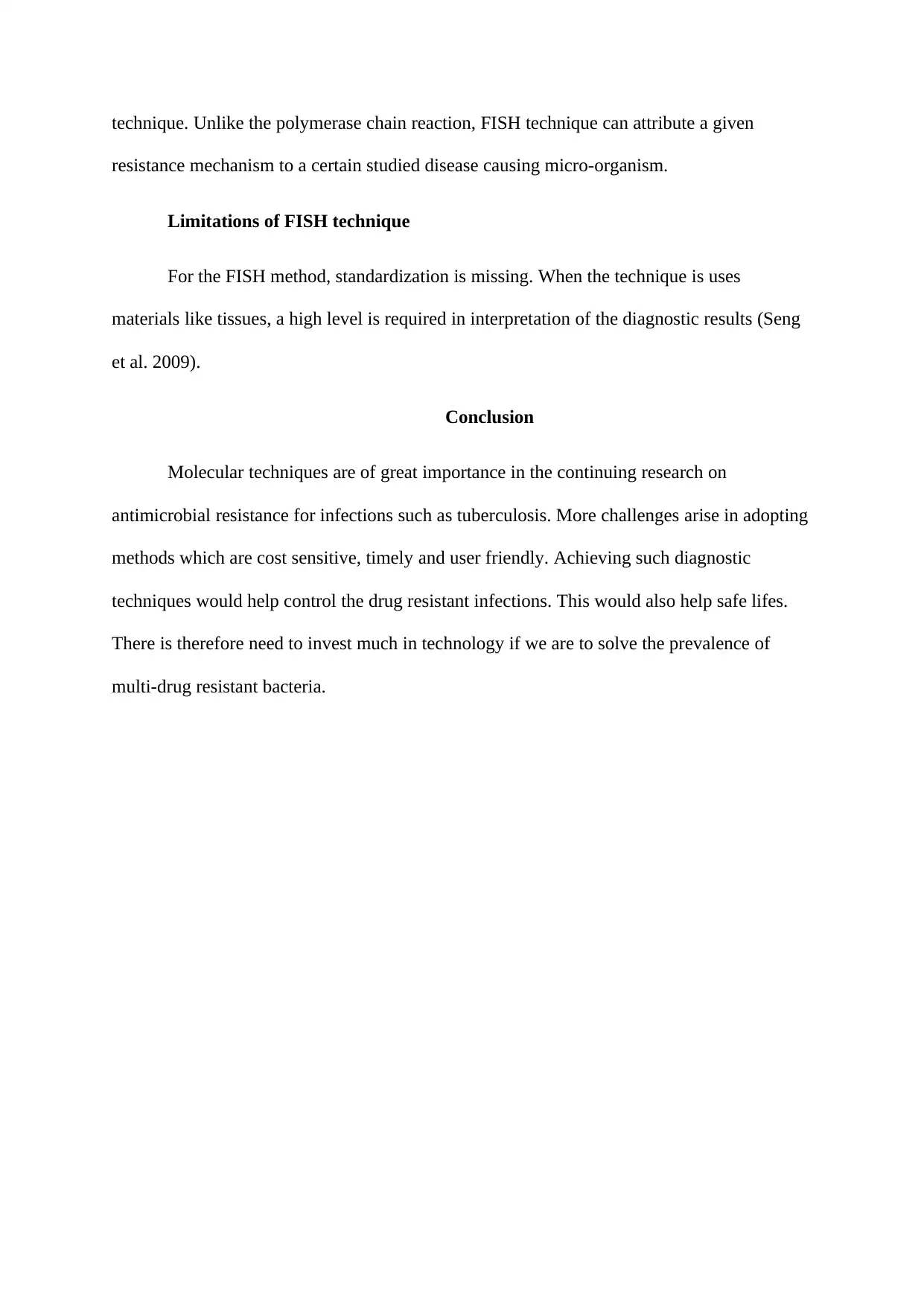
technique. Unlike the polymerase chain reaction, FISH technique can attribute a given
resistance mechanism to a certain studied disease causing micro-organism.
Limitations of FISH technique
For the FISH method, standardization is missing. When the technique is uses
materials like tissues, a high level is required in interpretation of the diagnostic results (Seng
et al. 2009).
Conclusion
Molecular techniques are of great importance in the continuing research on
antimicrobial resistance for infections such as tuberculosis. More challenges arise in adopting
methods which are cost sensitive, timely and user friendly. Achieving such diagnostic
techniques would help control the drug resistant infections. This would also help safe lifes.
There is therefore need to invest much in technology if we are to solve the prevalence of
multi-drug resistant bacteria.
resistance mechanism to a certain studied disease causing micro-organism.
Limitations of FISH technique
For the FISH method, standardization is missing. When the technique is uses
materials like tissues, a high level is required in interpretation of the diagnostic results (Seng
et al. 2009).
Conclusion
Molecular techniques are of great importance in the continuing research on
antimicrobial resistance for infections such as tuberculosis. More challenges arise in adopting
methods which are cost sensitive, timely and user friendly. Achieving such diagnostic
techniques would help control the drug resistant infections. This would also help safe lifes.
There is therefore need to invest much in technology if we are to solve the prevalence of
multi-drug resistant bacteria.
Paraphrase This Document
Need a fresh take? Get an instant paraphrase of this document with our AI Paraphraser
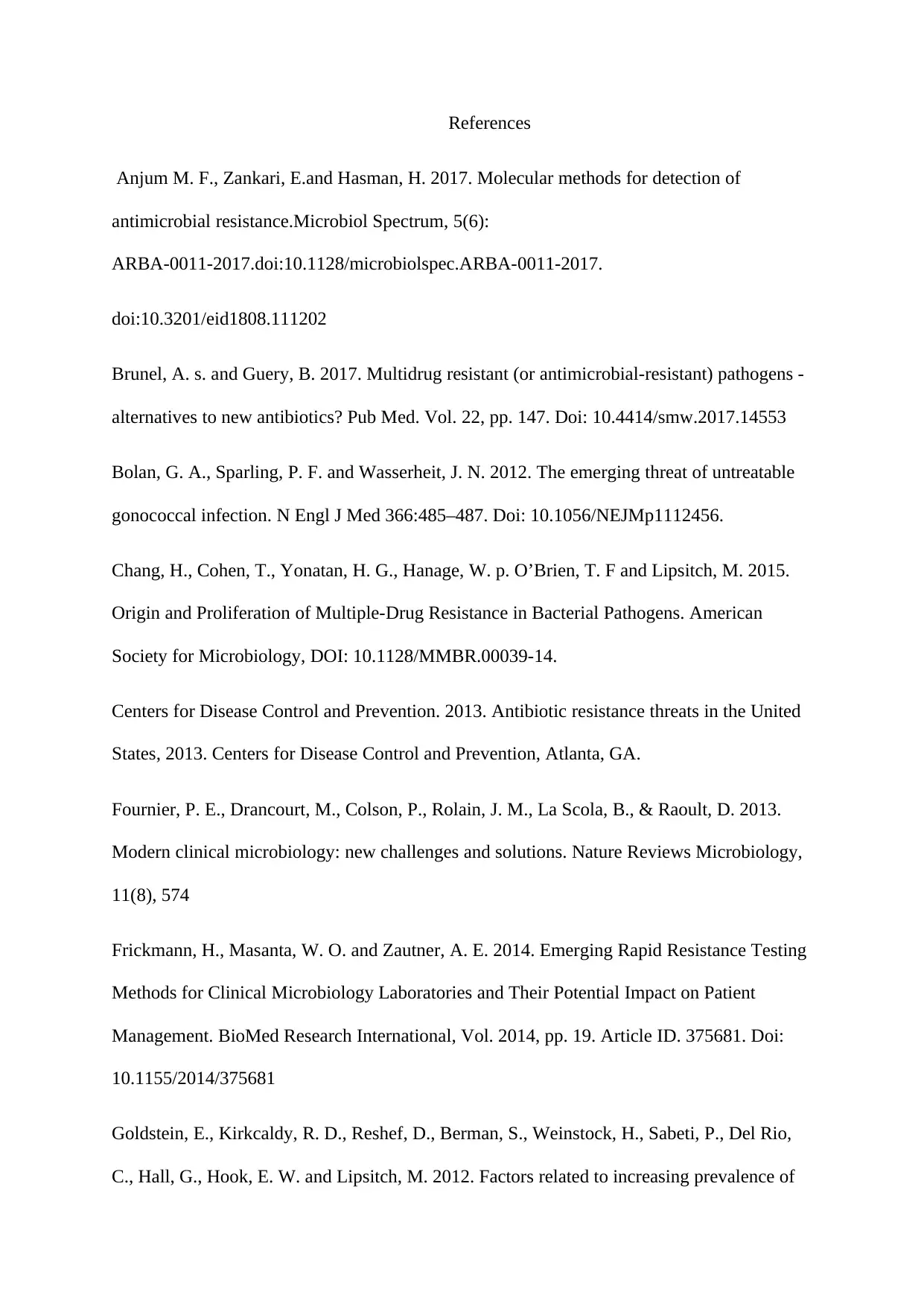
References
Anjum M. F., Zankari, E.and Hasman, H. 2017. Molecular methods for detection of
antimicrobial resistance.Microbiol Spectrum, 5(6):
ARBA-0011-2017.doi:10.1128/microbiolspec.ARBA-0011-2017.
doi:10.3201/eid1808.111202
Brunel, A. s. and Guery, B. 2017. Multidrug resistant (or antimicrobial-resistant) pathogens -
alternatives to new antibiotics? Pub Med. Vol. 22, pp. 147. Doi: 10.4414/smw.2017.14553
Bolan, G. A., Sparling, P. F. and Wasserheit, J. N. 2012. The emerging threat of untreatable
gonococcal infection. N Engl J Med 366:485–487. Doi: 10.1056/NEJMp1112456.
Chang, H., Cohen, T., Yonatan, H. G., Hanage, W. p. O’Brien, T. F and Lipsitch, M. 2015.
Origin and Proliferation of Multiple-Drug Resistance in Bacterial Pathogens. American
Society for Microbiology, DOI: 10.1128/MMBR.00039-14.
Centers for Disease Control and Prevention. 2013. Antibiotic resistance threats in the United
States, 2013. Centers for Disease Control and Prevention, Atlanta, GA.
Fournier, P. E., Drancourt, M., Colson, P., Rolain, J. M., La Scola, B., & Raoult, D. 2013.
Modern clinical microbiology: new challenges and solutions. Nature Reviews Microbiology,
11(8), 574
Frickmann, H., Masanta, W. O. and Zautner, A. E. 2014. Emerging Rapid Resistance Testing
Methods for Clinical Microbiology Laboratories and Their Potential Impact on Patient
Management. BioMed Research International, Vol. 2014, pp. 19. Article ID. 375681. Doi:
10.1155/2014/375681
Goldstein, E., Kirkcaldy, R. D., Reshef, D., Berman, S., Weinstock, H., Sabeti, P., Del Rio,
C., Hall, G., Hook, E. W. and Lipsitch, M. 2012. Factors related to increasing prevalence of
Anjum M. F., Zankari, E.and Hasman, H. 2017. Molecular methods for detection of
antimicrobial resistance.Microbiol Spectrum, 5(6):
ARBA-0011-2017.doi:10.1128/microbiolspec.ARBA-0011-2017.
doi:10.3201/eid1808.111202
Brunel, A. s. and Guery, B. 2017. Multidrug resistant (or antimicrobial-resistant) pathogens -
alternatives to new antibiotics? Pub Med. Vol. 22, pp. 147. Doi: 10.4414/smw.2017.14553
Bolan, G. A., Sparling, P. F. and Wasserheit, J. N. 2012. The emerging threat of untreatable
gonococcal infection. N Engl J Med 366:485–487. Doi: 10.1056/NEJMp1112456.
Chang, H., Cohen, T., Yonatan, H. G., Hanage, W. p. O’Brien, T. F and Lipsitch, M. 2015.
Origin and Proliferation of Multiple-Drug Resistance in Bacterial Pathogens. American
Society for Microbiology, DOI: 10.1128/MMBR.00039-14.
Centers for Disease Control and Prevention. 2013. Antibiotic resistance threats in the United
States, 2013. Centers for Disease Control and Prevention, Atlanta, GA.
Fournier, P. E., Drancourt, M., Colson, P., Rolain, J. M., La Scola, B., & Raoult, D. 2013.
Modern clinical microbiology: new challenges and solutions. Nature Reviews Microbiology,
11(8), 574
Frickmann, H., Masanta, W. O. and Zautner, A. E. 2014. Emerging Rapid Resistance Testing
Methods for Clinical Microbiology Laboratories and Their Potential Impact on Patient
Management. BioMed Research International, Vol. 2014, pp. 19. Article ID. 375681. Doi:
10.1155/2014/375681
Goldstein, E., Kirkcaldy, R. D., Reshef, D., Berman, S., Weinstock, H., Sabeti, P., Del Rio,
C., Hall, G., Hook, E. W. and Lipsitch, M. 2012. Factors related to increasing prevalence of
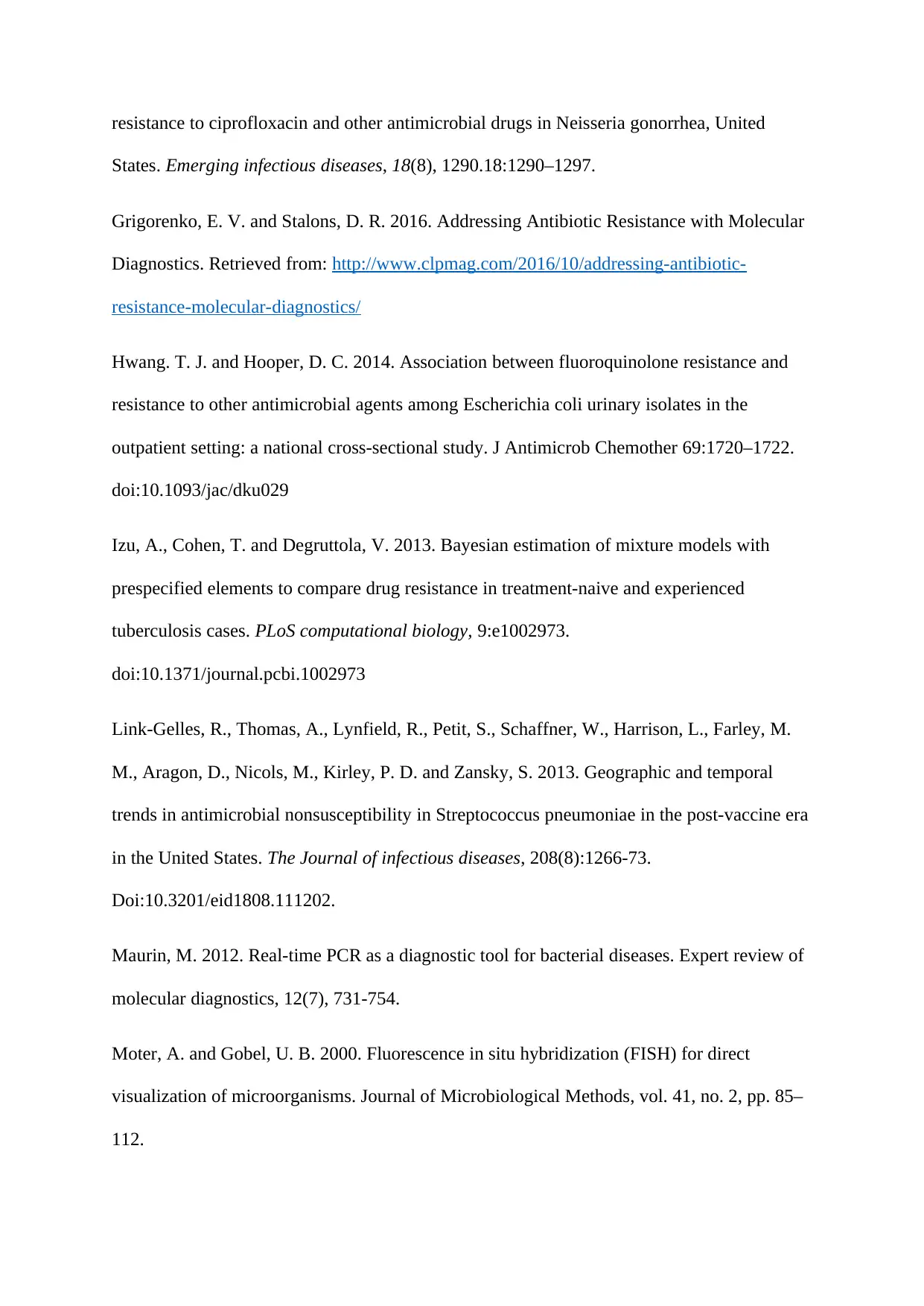
resistance to ciprofloxacin and other antimicrobial drugs in Neisseria gonorrhea, United
States. Emerging infectious diseases, 18(8), 1290.18:1290–1297.
Grigorenko, E. V. and Stalons, D. R. 2016. Addressing Antibiotic Resistance with Molecular
Diagnostics. Retrieved from: http://www.clpmag.com/2016/10/addressing-antibiotic-
resistance-molecular-diagnostics/
Hwang. T. J. and Hooper, D. C. 2014. Association between fluoroquinolone resistance and
resistance to other antimicrobial agents among Escherichia coli urinary isolates in the
outpatient setting: a national cross-sectional study. J Antimicrob Chemother 69:1720–1722.
doi:10.1093/jac/dku029
Izu, A., Cohen, T. and Degruttola, V. 2013. Bayesian estimation of mixture models with
prespecified elements to compare drug resistance in treatment-naive and experienced
tuberculosis cases. PLoS computational biology, 9:e1002973.
doi:10.1371/journal.pcbi.1002973
Link-Gelles, R., Thomas, A., Lynfield, R., Petit, S., Schaffner, W., Harrison, L., Farley, M.
M., Aragon, D., Nicols, M., Kirley, P. D. and Zansky, S. 2013. Geographic and temporal
trends in antimicrobial nonsusceptibility in Streptococcus pneumoniae in the post-vaccine era
in the United States. The Journal of infectious diseases, 208(8):1266-73.
Doi:10.3201/eid1808.111202.
Maurin, M. 2012. Real-time PCR as a diagnostic tool for bacterial diseases. Expert review of
molecular diagnostics, 12(7), 731-754.
Moter, A. and Gobel, U. B. 2000. Fluorescence in situ hybridization (FISH) for direct
visualization of microorganisms. Journal of Microbiological Methods, vol. 41, no. 2, pp. 85–
112.
States. Emerging infectious diseases, 18(8), 1290.18:1290–1297.
Grigorenko, E. V. and Stalons, D. R. 2016. Addressing Antibiotic Resistance with Molecular
Diagnostics. Retrieved from: http://www.clpmag.com/2016/10/addressing-antibiotic-
resistance-molecular-diagnostics/
Hwang. T. J. and Hooper, D. C. 2014. Association between fluoroquinolone resistance and
resistance to other antimicrobial agents among Escherichia coli urinary isolates in the
outpatient setting: a national cross-sectional study. J Antimicrob Chemother 69:1720–1722.
doi:10.1093/jac/dku029
Izu, A., Cohen, T. and Degruttola, V. 2013. Bayesian estimation of mixture models with
prespecified elements to compare drug resistance in treatment-naive and experienced
tuberculosis cases. PLoS computational biology, 9:e1002973.
doi:10.1371/journal.pcbi.1002973
Link-Gelles, R., Thomas, A., Lynfield, R., Petit, S., Schaffner, W., Harrison, L., Farley, M.
M., Aragon, D., Nicols, M., Kirley, P. D. and Zansky, S. 2013. Geographic and temporal
trends in antimicrobial nonsusceptibility in Streptococcus pneumoniae in the post-vaccine era
in the United States. The Journal of infectious diseases, 208(8):1266-73.
Doi:10.3201/eid1808.111202.
Maurin, M. 2012. Real-time PCR as a diagnostic tool for bacterial diseases. Expert review of
molecular diagnostics, 12(7), 731-754.
Moter, A. and Gobel, U. B. 2000. Fluorescence in situ hybridization (FISH) for direct
visualization of microorganisms. Journal of Microbiological Methods, vol. 41, no. 2, pp. 85–
112.
⊘ This is a preview!⊘
Do you want full access?
Subscribe today to unlock all pages.

Trusted by 1+ million students worldwide
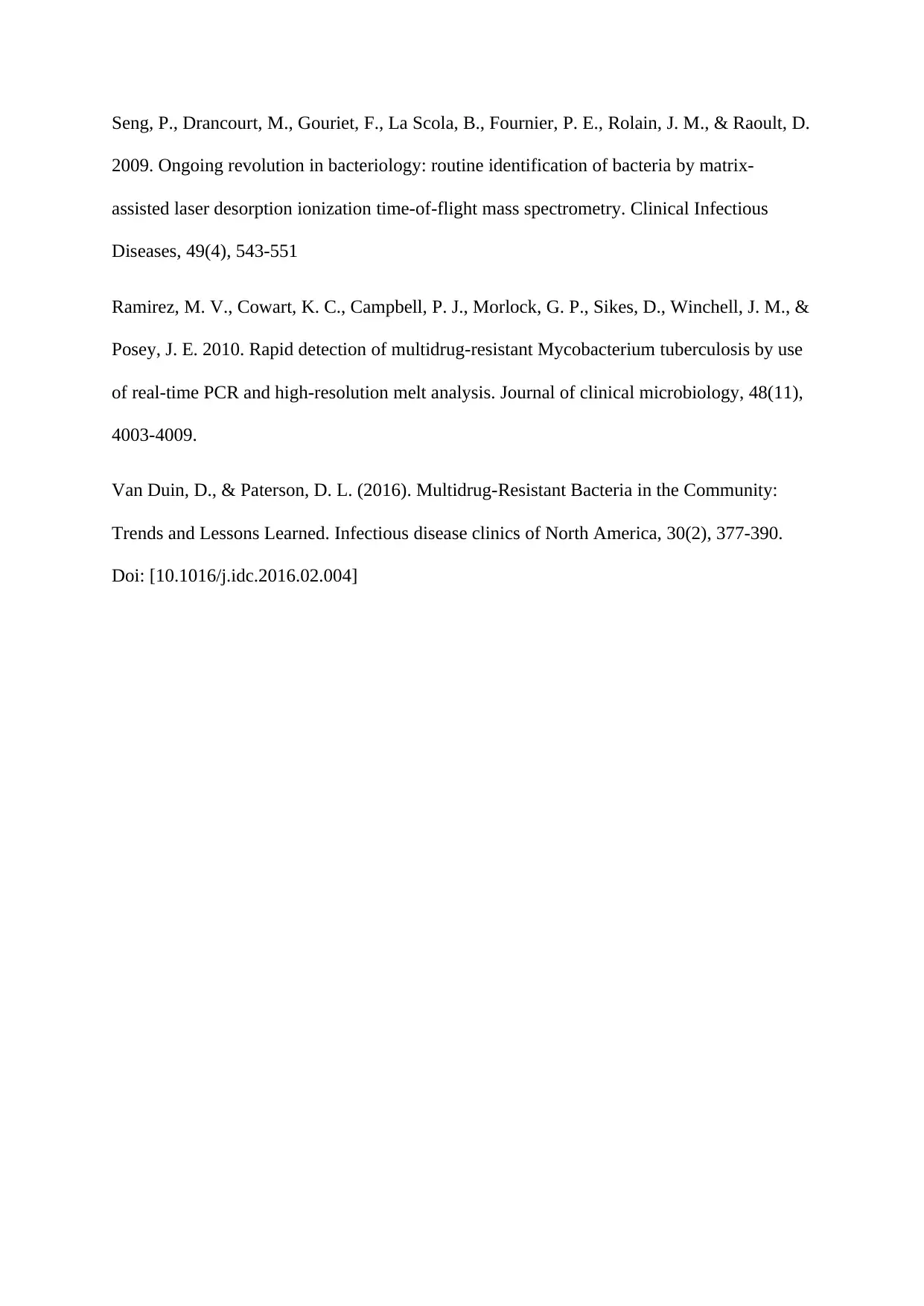
Seng, P., Drancourt, M., Gouriet, F., La Scola, B., Fournier, P. E., Rolain, J. M., & Raoult, D.
2009. Ongoing revolution in bacteriology: routine identification of bacteria by matrix-
assisted laser desorption ionization time-of-flight mass spectrometry. Clinical Infectious
Diseases, 49(4), 543-551
Ramirez, M. V., Cowart, K. C., Campbell, P. J., Morlock, G. P., Sikes, D., Winchell, J. M., &
Posey, J. E. 2010. Rapid detection of multidrug-resistant Mycobacterium tuberculosis by use
of real-time PCR and high-resolution melt analysis. Journal of clinical microbiology, 48(11),
4003-4009.
Van Duin, D., & Paterson, D. L. (2016). Multidrug-Resistant Bacteria in the Community:
Trends and Lessons Learned. Infectious disease clinics of North America, 30(2), 377-390.
Doi: [10.1016/j.idc.2016.02.004]
2009. Ongoing revolution in bacteriology: routine identification of bacteria by matrix-
assisted laser desorption ionization time-of-flight mass spectrometry. Clinical Infectious
Diseases, 49(4), 543-551
Ramirez, M. V., Cowart, K. C., Campbell, P. J., Morlock, G. P., Sikes, D., Winchell, J. M., &
Posey, J. E. 2010. Rapid detection of multidrug-resistant Mycobacterium tuberculosis by use
of real-time PCR and high-resolution melt analysis. Journal of clinical microbiology, 48(11),
4003-4009.
Van Duin, D., & Paterson, D. L. (2016). Multidrug-Resistant Bacteria in the Community:
Trends and Lessons Learned. Infectious disease clinics of North America, 30(2), 377-390.
Doi: [10.1016/j.idc.2016.02.004]
1 out of 10
Related Documents
Your All-in-One AI-Powered Toolkit for Academic Success.
+13062052269
info@desklib.com
Available 24*7 on WhatsApp / Email
![[object Object]](/_next/static/media/star-bottom.7253800d.svg)
Unlock your academic potential
Copyright © 2020–2025 A2Z Services. All Rights Reserved. Developed and managed by ZUCOL.




